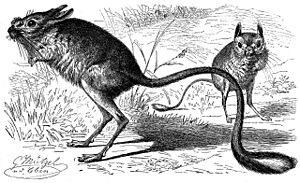Great jerboa facts for kids
Quick facts for kids Great jerboa |
|
|---|---|
 |
|
| Conservation status | |
| Scientific classification | |
| Genus: |
Allactaga
|
| Species: |
major
|
| Synonyms | |
|
Allactaga jaculus (Kerr, 1792) |
|
The great jerboa (Allactaga major) is a type of rodent that belongs to the Dipodidae family. Think of it as a hopping mouse with long legs! It lives in countries like Kazakhstan, Russia, Turkmenistan, Ukraine, and Uzbekistan. You'll mostly find these amazing animals living in deserts.
Contents
What is a Great Jerboa?
The great jerboa is the largest kind of jerboa. Its body can be about 18 centimeters (7 inches) long. Its tail is even longer, reaching up to 26 centimeters (10 inches). This long tail helps it balance when it hops!
Where Do Great Jerboas Live?
Great jerboas live in the wide, open grasslands called steppes and northern deserts. You can find them from western Ukraine and European Russia, all the way through Kazakhstan and Uzbekistan, to eastern Siberia and western China.
They like places with thin grass, slopes in small valleys, and even along roads or field edges. They also live in dry or partly dry areas, especially where some juicy plants grow. Great jerboas prefer to live in ground that is made of clay.
How Do Great Jerboas Live?
Great jerboas are very good at digging. They make different types of homes called burrows.
Jerboa Burrows
They have special burrows for summer and winter. These are their permanent homes. They also dig temporary burrows when they need a quick hiding spot.
What Do Jerboas Eat?
Great jerboas love to eat plant bulbs. Their favorite food is the bulbs from a plant called Gagea. They use their strong teeth to dig out these tasty bulbs from the ground. Sometimes, they also eat grains and tree bark.
Jerboa Hibernation
When the weather gets cold, great jerboas go into hibernation. This is like a long sleep that lasts from the first frost until spring arrives. Sometimes, several great jerboas will even hibernate together in one cozy nest!
Life Cycle and Reproduction
Great jerboas usually have babies in the late spring and summer. A mother jerboa can have two groups of babies, called litters, during this time. Each litter usually has about three to six young jerboas.
Is the Great Jerboa in Danger?
The great jerboa lives in a very large area, and in many places, there are lots of them. So, the International Union for Conservation of Nature (IUCN) says it is of "least concern". This means it's not currently in great danger of disappearing.
However, in Ukraine and European Russia, their homes are changing. More farms are being built, and other human activities are changing the land. For example, they have disappeared from the Moscow area because of new buildings and other changes. Because of these changes, experts think we should keep an eye on their populations to make sure they stay safe.



